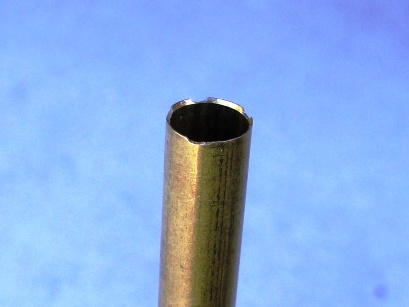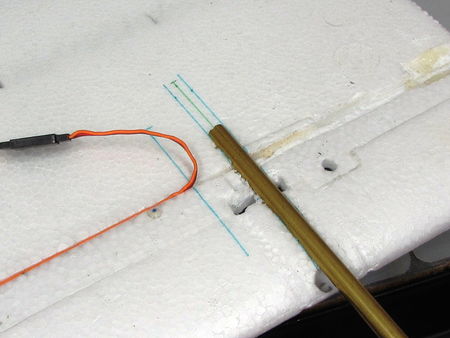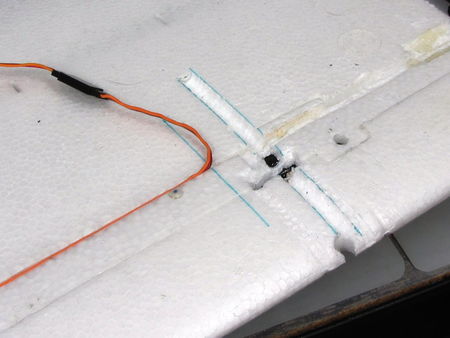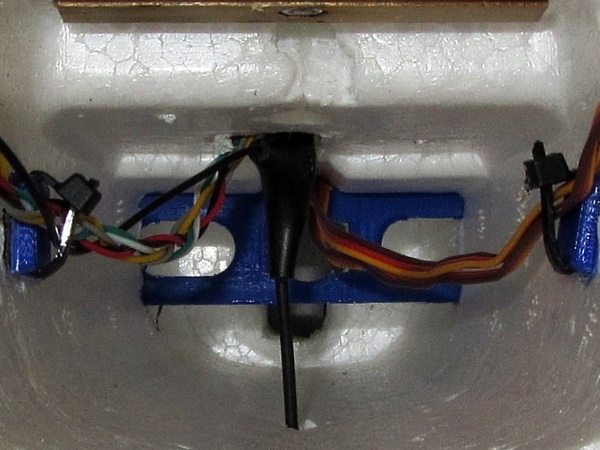Difference between revisions of "X-UAV Mini Talon VTOL Project"
(→Project 3D Print Files) |
(→Flight Control) |
||
| Line 455: | Line 455: | ||
<br> | <br> | ||
| − | + | Of course with adding two motors, two servos and a mag compass there are a few more wires to deal with! THe Matek board does a great job in keeping the wiring simple and manageable. | |
| + | <br> | ||
| + | {| border="0" cellspacing="1" cellpadding="1" width="800" align="center" | ||
| + | |- | ||
| + | | align="center" | [[File:MTV54.jpg|900px]] | ||
| + | |} | ||
<br><br> | <br><br> | ||
Revision as of 20:45, 25 October 2019
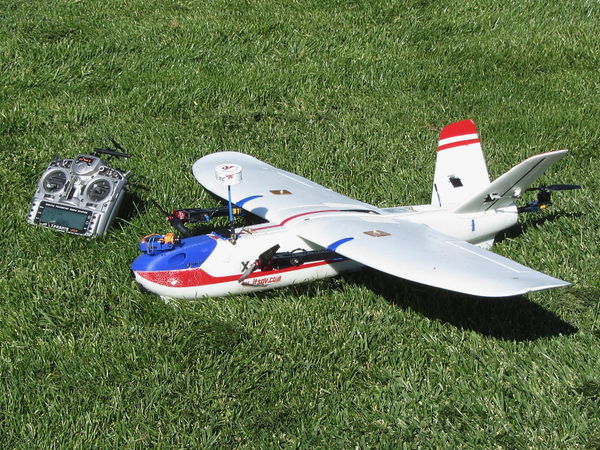
| |
| Ready for lift-off! |
Introduction
First, some acknowledgements-
Many thanks to ATX_Heli from RCGroups and the APM dev team, Tridge, also from RCG and the APM dev team and Greg Covey who did a really great write-up of his E-Flite Convergence conversion to APM. Their combined help and write-ups were invaluable to this project!
My MiniTalon #4 is getting long in the tooth after nearly 2-1/2 years and hundreds of flights so I decided to use it as a test platform for this project. (Please see X-UAV Mini Talon Build Number 4 for any build information not found here.) I have been resisting doing a VTOL version of the Mini Talon because I knew it would be an all consuming project that would take some time. It has been!. It has also been a really fun and challenging project and hopefully the results will speak for themselves.
To begin, when I first started on this project I set up some simple design parameters to aim for:
- Relatively light weight - <1750g with a 5200/4S Lipo pack
- Minimum Carbon Fiber components - To keep any RF interference low
- Three-motor tilt rotor configuration - This should help with the weight
- Bolt-on rear motor mount - Keeps stock motor mount
- No additional booms or struts added to the fuselage (modified wings only)
- The ability to use the Matek F405-wing flight controller and all the flight control components already on the plane
So far nearly all of this has been achieved with only one small (4.2g) support bracket in the fuse and a little extra weight above my initial parameter (+42g)
Below are my build notes, print files and a flight review of this new Mini Talon configuration.
General Specifications
Initial Build
Seller - ReadyMadeRC, USA
Aircraft - X_UAV Mini Talon
Modification Date - October, 2019
| Airframe Type - | Top Wing V-Tail FPV Specialist | All-Up Weight - | 63oz (1792g) w/ 4S/5200 Lipo Pack | |
| Wingspan - | 51 inches (1300mm) | Length - | 38 inches (965mm) | |
| Wing Area - | 3.23 ft^2 (30dm^2) | Wing Load w/5.2-4S - | 19.5 oz/ft^2 (59g/dm^2) | |
| Front Motors - | BrotherHobby 2806.5-1300kv | Rear Motor - | Cobra CPL2207-1800kv | |
| Front Propellers - | Graupner 8x5 E-Prop (4S) | Rear Propeller - | HQProp 6x4.5 Bull Nose | |
| *Lifting Static Thrust - | 3365g | *Forward Static Thrust - | 2744g | |
| Lifting Static Thrust:Weight - | 1.9 | Forward Static Thrust:Weight - | 1.5 | |
| Max Continuous Power (4S) - | 1175 watts continuous (4S) | Max Forward Flight Power - | 874 watts continuous (4S) | |
| Battery Type - | 4S1P 5.2Ah Multistar Lipo | In-Flight Battery Capacity - | 4400mah/10C (85%) | |
| In flight efficiency - | TBA | Flight Time - | TBA | |
| COG - | 60mm @ Wing root (Stock) | *Static Test Conditions | @ 2550ft ASL |
Components/Flight Gear
Power Set-up
To determine front and rear motor sizes I first looked at how the weight of the plane would be distributed with respect to the three lift points and a CG of 60mm from the leading edge. The image below shows the weight mapping for the current 1792g AUW:
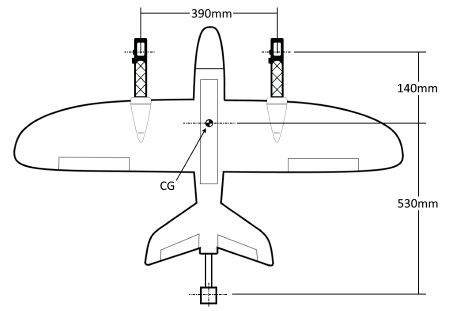
|
From this picture I determined the front motors need to lift 709 grams each and the rear motor, 374 grams for a theoretical stable hover. What I then did was look for motors as light as possible that could produce near these thrust numbers at 60% or less throttle.
With this information, I started with Racestar 2508-1275 motors on the front and a Cobra CPL2207-1800 motor on the rear. The Racestar motors worked well enough for my initial hover tests but I felt I needed a little more power and so they were replaced with Brotherhobby 2806.5-1300 units to get a bit more lift power and more headroom on the motor current.
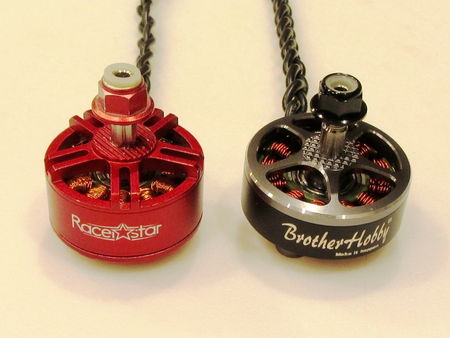
|
| Racestar 2508 and Brotherhobby 2806.5 |
For motor control I have chosen HGLRC Trex 60A, BLHeli_32 Opto ESC's with Active Freewheeling enabled. On all three motors I am using MR30, 3 pin connectors so they can easily be changed or reversed. Props were determined from bench testing with a 4S pack. The 8x5 Graupner front props are one of my favorite 8" Multirotor props and they also work extremely well on fixed wing.
Power Parts
- Front Motors - Brotherhobby Avenger 2806.5-1300kv
- Rear Motors - Cobra CPL2207-1800kv
- ESC - HGLRC T-Rex 60A BLHeli_32 ESC
- Left Front Prop - HQProp 6 x 4.5 Bull Nose-CW
- Right Front Prop - HQProp 6 x 4.5 Bull Nose-CCW
- Battery - Multistar 4S/5200, 10C, 438g
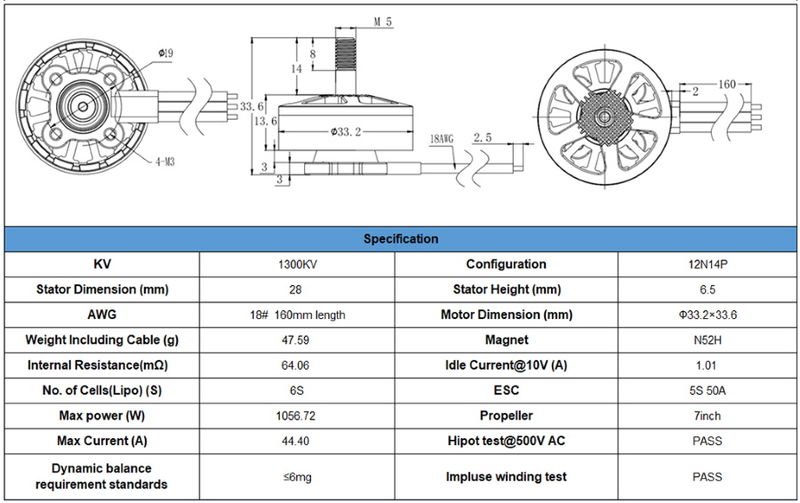
|
| Brotherhobby specification |

|
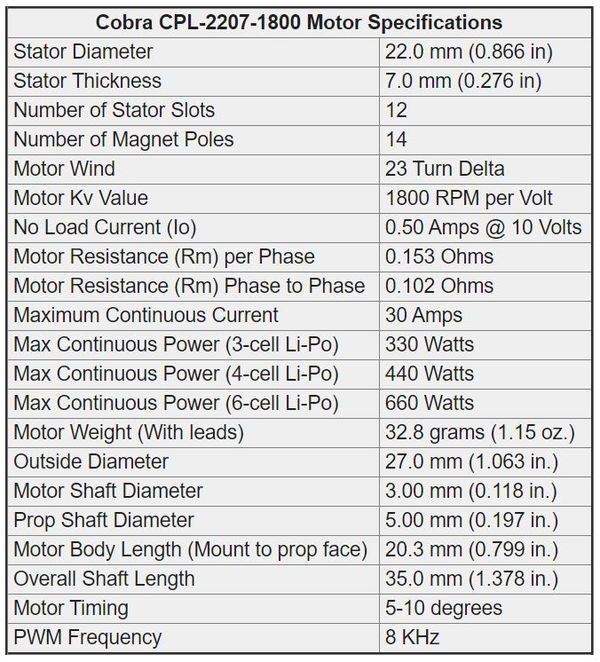
|
| Cobra specification |

|
Front Motor Mounts
This design has had many revisions to date and likely will have a few more. Again my goal was to make it light, simple and strong.

|
While I won't show all the versions and revisions of the front mounts, here are a few:
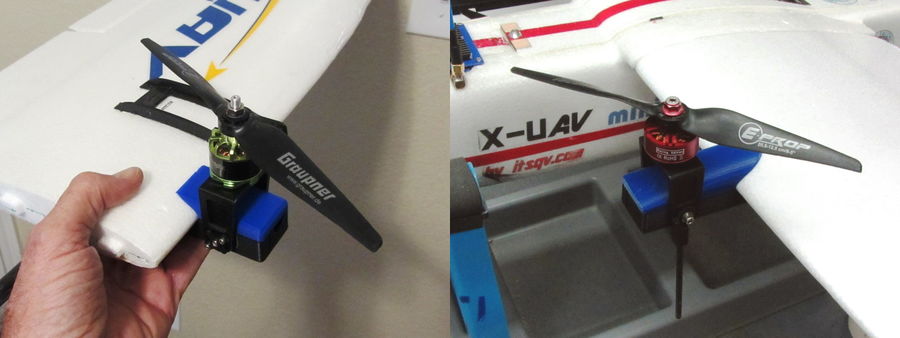
|
| Version 1/2 |
Version 3 was very similar with a stretched out mount. It looked nice but I felt it still blocked too much of the prop thrust.
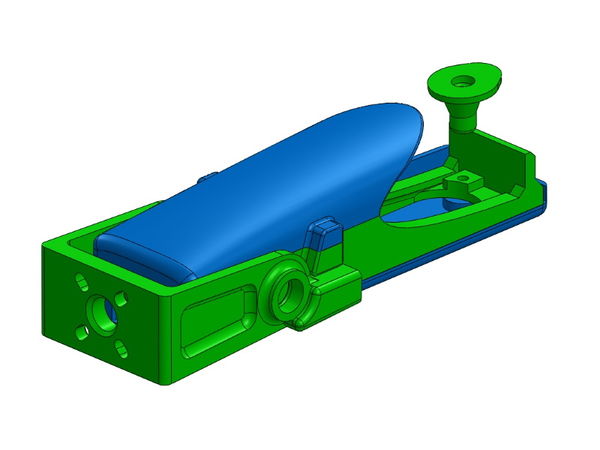
|
| Version 3 |
For a short time I considered an offset mount so that I could use a larger prop and not have the forward flight position too far forward. The problem with this idea is, I would need a much larger, more powerfull servo.
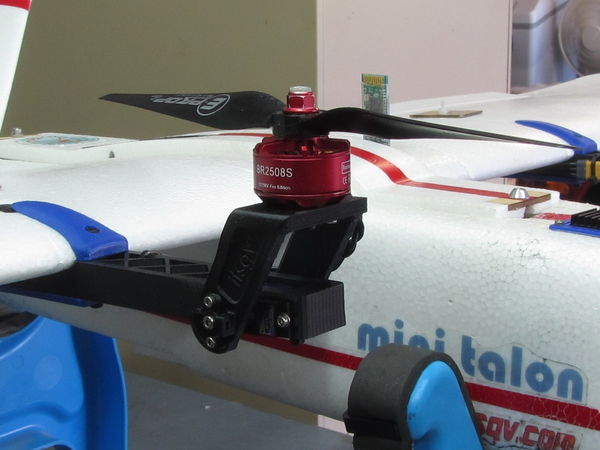
|
| Version 4 |
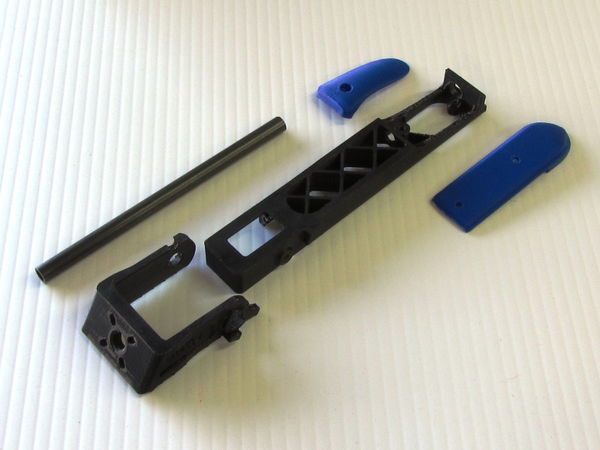
|
| Version 4 parts |
The current version (6) uses the main mount piece from V4 and a straight motor mount together with an 8mm x 135mm CF tube to get the moment forces spread across more of the wing.
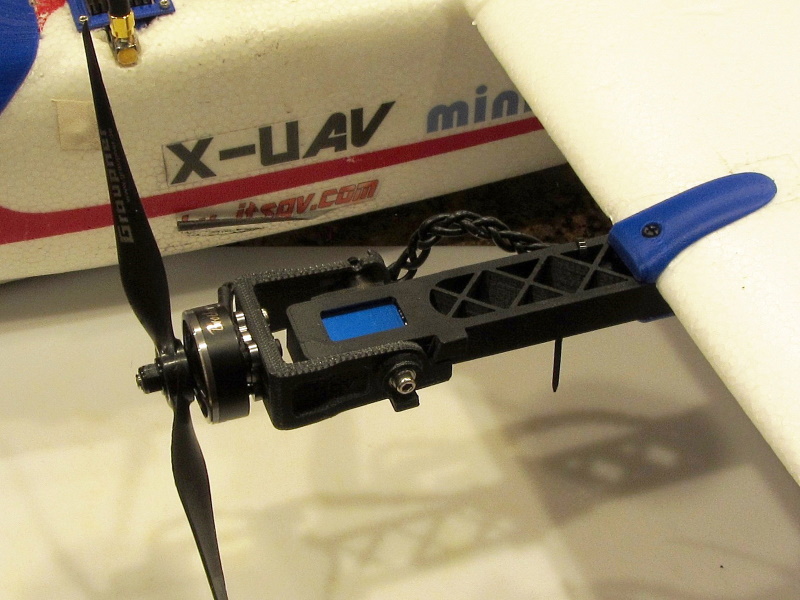
|
| Current Set-up |
Front Motor Mounts Assembly
The front assemblies are identical for left and right with only the routing of the motor wires being different. The main structure consists of an arm with a support tube and a motor mount bracket which is supported by the servo on one side and a ball bearing on the opposite side. The support tube is in alignment with the center of the motor. There is also a bottom cover which hide and protect wiring and a top cover which helps secure the arm to the top of the wing.
Below is an image of one motor/arm assembly:
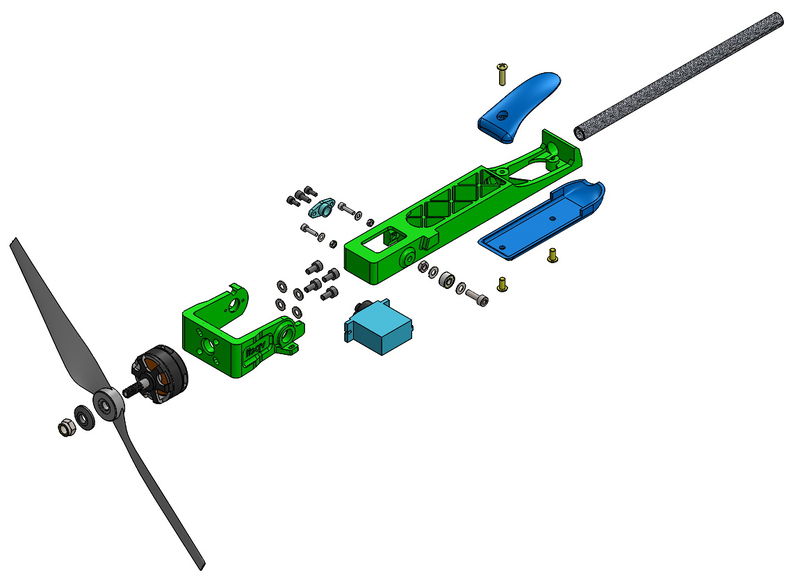
|
The groove represents the center-line of the motor so they are equidistant from the edge of the wing panel. In my case I cut them with centers at 125mm which is enough clearance for a 9" prop.
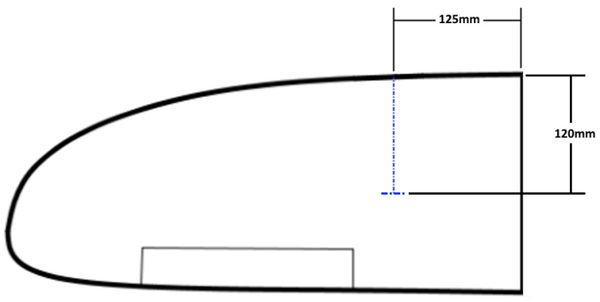
|
| Groove position |
|
|
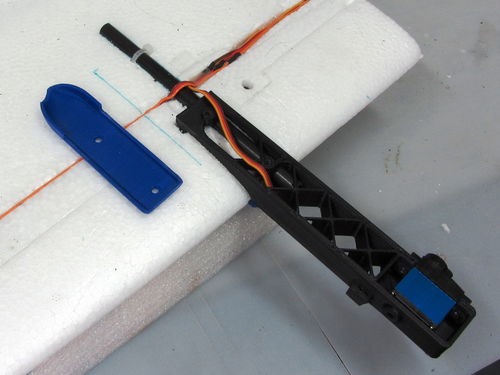
|
| Mounted! |
Rear Motor Mount
For the rear mount I wanted to keep it simple, light weight and easy to install using the stock rear motor mount.
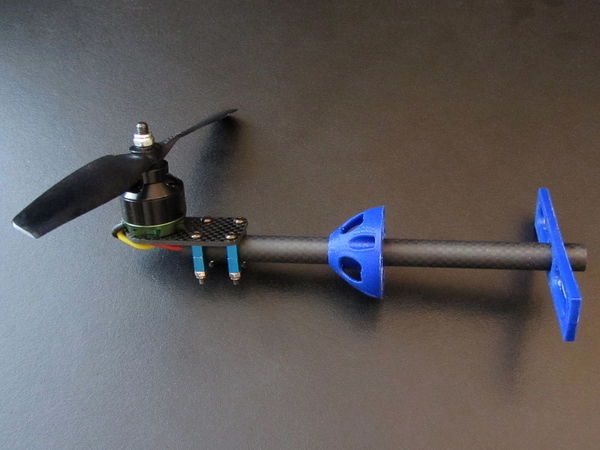
|
| Rear mount assembly |
Rear Motor Mount Assembly
The rear motor assembly consists of a CF boom tube, motor plate and two support pieces to hold the boom. The front support is cut and glued into the fuselage at a distance of 110mm to 115mm from the rear edge of the fuselage. One side of this bracket is flanged so a little inlay work should be done to keep it flush. The top of this bracket is flush against the roof of the fuselage. The rear support bolts directly to the motor mount and will fit mounts with 33mm to 34mm hole spacing. There are two holes for nylon anti-rotation screws that need to be tapped to M3.
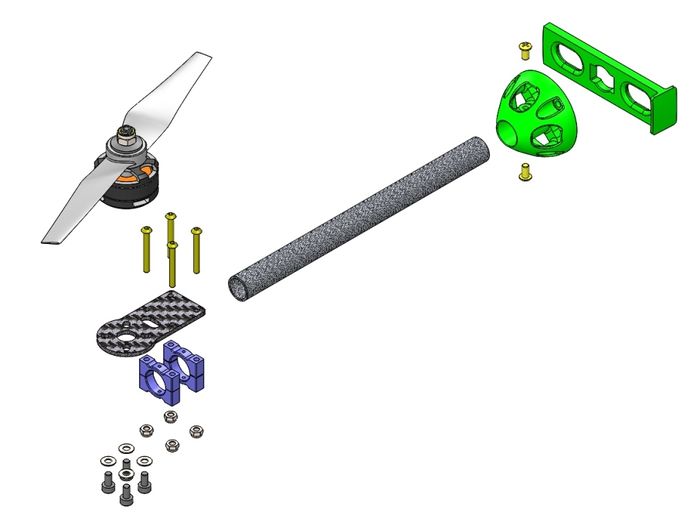
|
| Rear VTOL Assembly |
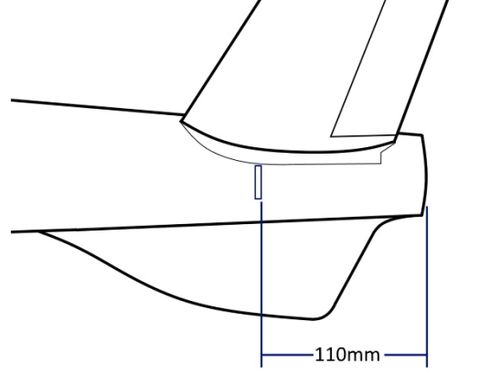
|
| Support bracket cut |
Rear mount assembly parts:
|
|
Below is a drawing of the motor plate I made from 2mm CF sheet. You could use 3mm plywood treated with thin CA or G10 fiberglass if CF sheet is not available. Your dimensions may vary depending on the hole spacing for the tube clamps you buy and the motor you elect to use.
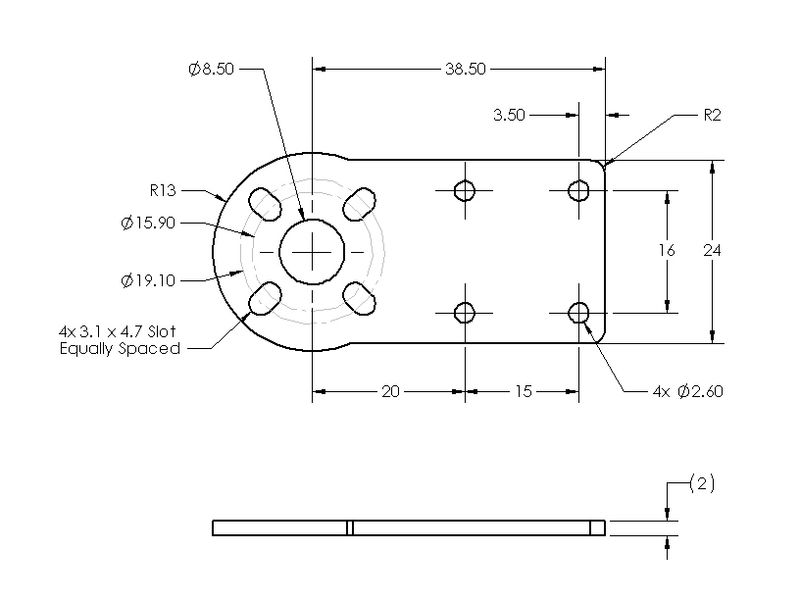
|
| Rear motor plate detail |
Flight Control
For flight control I stayed with the Matek F405-wing with Chibios/Arduplane running with Q_Plane parameters enabled. For the initial vertical flight test I ran it with all default parameters on the flight control parts. The only adjustments (to the parameters) were the motor tilt angles needing needing to be set-up at 0 and 90 degrees. For the first flight shown in the Transition video, I changed the parameter which controls pitch trim between vertical and forward flight, a couple of recommended yaw parameters and I added a little expo to my transmitter to soften up response in vertical flight.
Of course with adding two motors, two servos and a mag compass there are a few more wires to deal with! THe Matek board does a great job in keeping the wiring simple and manageable.
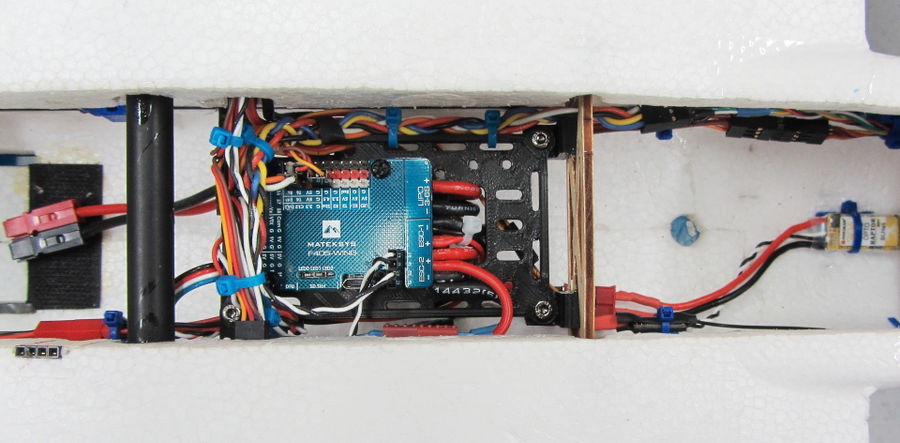
|
First Flight!
19 October, 2019
So, in a word AWESOME!! Going from a hover to forward flight was a little nerve racking but when I finally threw the switch it blew my mind how fast and stable the plane was. The video below does not do the acceleration justice! I threw the switch when the plane was at about 20ft altitude and then stood there in complete shock watching it effortlessly rocket away. In forward flight it is a little harder to turn sharply and this may be due to the position of the forward props and also I have the max-roll setting quite low in Arduplane. It flew very much like my last twin did so very stable and extremely quiet. It would cruise easily at ~4-4.2A although the plane speed was a bit low. I'll have to try some different props going forward.
Unfortunately I never got to switch it back to hover mode because I wasn't paying attention to forward speed when I turned into the wind for a landing, I got impatient and cranked the rudder to turn more sharply and she snap rolled/tip stalled without enough altitude to recover. This would be unusual in any of my standard Mini Talons and I'll have to check the rudder settings to see if I have them over saturated (likely).
Anyway, even though I stuffed it, I'm extremely happy with how it performed and will get it back together very soon.
Video
|
First Flight! - 1 February, 2019 |
Parting Shot
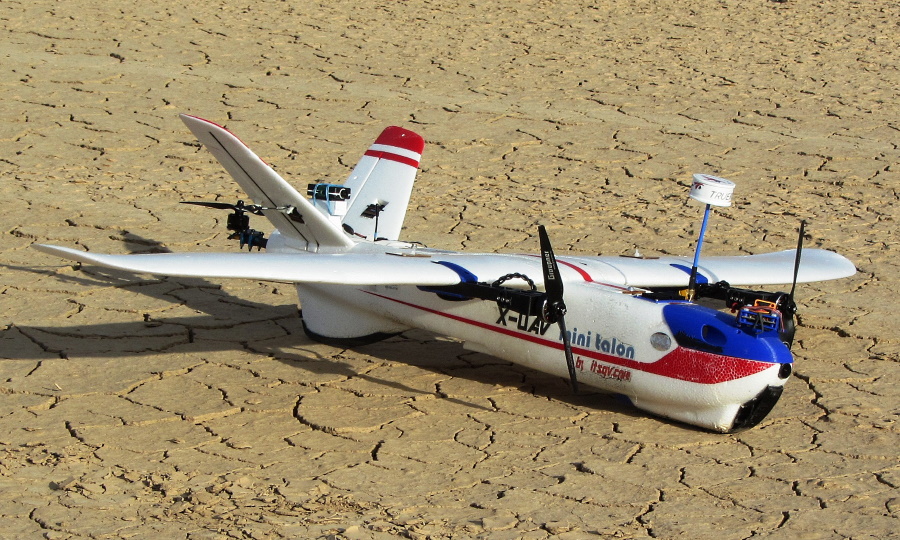
|
| Take-off ready! |
Project 3D Print Files
All prints are setup with 50%-90% infill and a 1mm shell thickness. Weights are shown as printed in Hatchbox ABS.
| Image | Part Number | Part Description | Weight/Infill | Print File | Compatibility Notes |
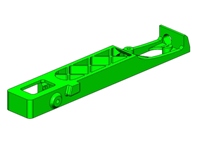
|
52220 | MT VTOL Front Arm 80mm | 15.7g/90% | 52220.STL | 80mm Front Motor Arm |
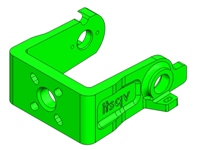
|
52221 | MT VTOL Motor Mount Bracket | 8.2g/90% | 52221.STL | Fits motors with 16-19mm mount holes |
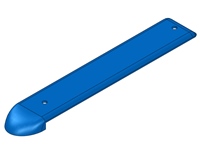
|
52222 | MT VTOL Front Lower Assembly Cover | 3.4g/50% | 52222.STL | Wiring cover for the front wing mount |
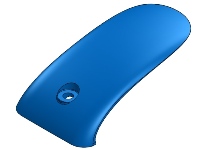
|
52223 | MT VTOL Front Upper Assembly Cover | 2.2g/50% | 52223.STL | Clamping cover for the front wing mount |
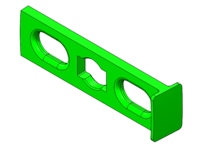
|
52224 | MT VTOL Rear Motor mount Forward Support Bracket | 4.2g/80% | 52224.STL | Front support for the 12mm CF tube |
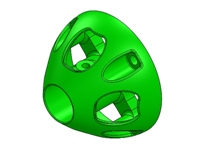
|
52225 | MT VTOL Rear Motor Mount Support | 5.3g/70% | 52225.STL | Rear support for the 12mm CF tube UPDATE - Now fits 33mm & 34mm mounts |
See Also
Some of the Vendors I used for this project
Comments? Questions?
